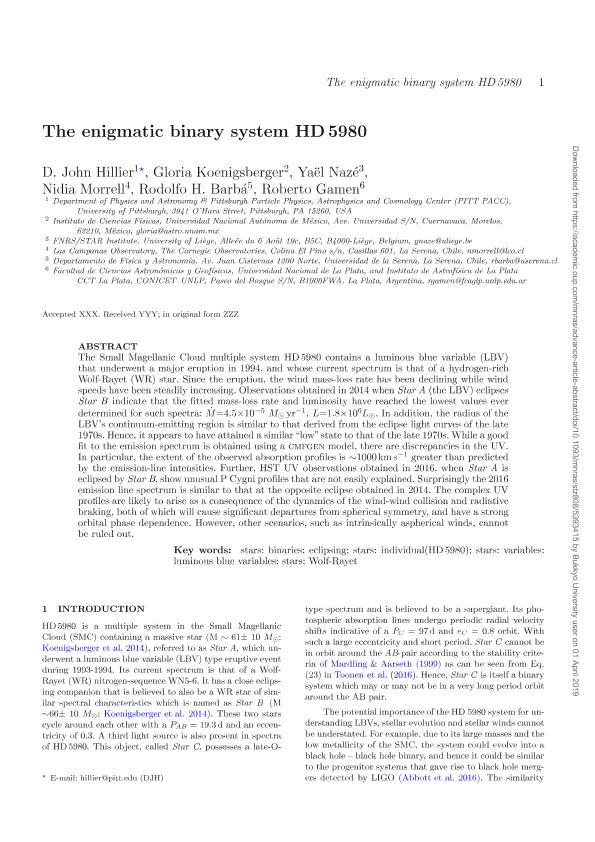Mostrar el registro sencillo del ítem
dc.contributor.author
Hillier, Desmond John

dc.contributor.author
Koenigsberger, Gloria
dc.contributor.author
Nazé, Yaël

dc.contributor.author
Morrell, Nidia Irene

dc.contributor.author
Barbá, Rodolfo

dc.contributor.author
Gamen, Roberto Claudio

dc.date.available
2021-02-11T02:17:55Z
dc.date.issued
2019-03-19
dc.identifier.citation
Hillier, Desmond John; Koenigsberger, Gloria; Nazé, Yaël; Morrell, Nidia Irene; Barbá, Rodolfo; et al.; The enigmatic binary system HD 5980; Wiley Blackwell Publishing, Inc; Monthly Notices of the Royal Astronomical Society; 486; 1; 19-3-2019; 725-742
dc.identifier.issn
0035-8711
dc.identifier.uri
http://hdl.handle.net/11336/125384
dc.description.abstract
The Small Magellanic Cloud multiple system HD 5980 contains a luminous blue variable (LBV) that underwent a major eruption in 1994, and whose current spectrum is that of a hydrogen-rich Wolf-Rayet (WR) star. Since the eruption, the wind mass-loss rate has been declining while wind speeds have been steadily increasing. Observations obtained in 2014 when Star A (the LBV) eclipses Star B indicate that the fitted mass-loss rate and luminosity have reached the lowest values ever determined for such spectra: dot{M} = 4.5 × 10-5M_☉ yr^{-1}, L = 1.7 × 106 L☉. In addition, the radius of the LBV´s continuum-emitting region is similar to that derived from the eclipse light curves of the late 1970s. Hence, it appears to have attained a similar `low´ state to that of the late 1970s. While a good fit to the emission spectrum is obtained using a CMFGEN model, there are discrepancies in the UV. In particular, the extent of the observed absorption profiles is ̃1000 km s-1 greater than predicted by the emission-line intensities. Further, HST UV observations obtained in 2016, when Star A is eclipsed by Star B, show unusual P Cygni profiles that are not easily explained. Surprisingly the 2016 emission-line spectrum is similar to that at the opposite eclipse obtained in 2014. The complex UV profiles are likely to arise as a consequence of the dynamics of the wind-wind collision and radiative braking, both of which will cause significant departures from spherical symmetry, and have a strong orbital phase dependence. However, other scenarios, such as intrinsically aspherical winds, cannot be ruled out.
dc.format
application/pdf
dc.language.iso
eng
dc.publisher
Wiley Blackwell Publishing, Inc

dc.rights
info:eu-repo/semantics/openAccess
dc.rights.uri
https://creativecommons.org/licenses/by-nc-sa/2.5/ar/
dc.subject
binaries: eclipsing
dc.subject
stars: individual(HD 5980)
dc.subject
stars: Wolf-Rayet
dc.subject
stars: winds
dc.subject
outflows
dc.subject
stars: mass-loss
dc.subject.classification
Astronomía

dc.subject.classification
Ciencias Físicas

dc.subject.classification
CIENCIAS NATURALES Y EXACTAS

dc.title
The enigmatic binary system HD 5980
dc.type
info:eu-repo/semantics/article
dc.type
info:ar-repo/semantics/artículo
dc.type
info:eu-repo/semantics/publishedVersion
dc.date.updated
2020-11-19T22:02:31Z
dc.journal.volume
486
dc.journal.number
1
dc.journal.pagination
725-742
dc.journal.pais
Reino Unido

dc.description.fil
Fil: Hillier, Desmond John. University of Pittsburgh; Estados Unidos
dc.description.fil
Fil: Koenigsberger, Gloria. Universidad Nacional Autónoma de México; México
dc.description.fil
Fil: Nazé, Yaël. Université de Liège; Bélgica
dc.description.fil
Fil: Morrell, Nidia Irene. Carnegie Institution. Observatorio Las Campanas; Chile. Consejo Nacional de Investigaciones Científicas y Técnicas. Centro Científico Tecnológico Conicet - La Plata. Instituto de Astrofísica La Plata. Universidad Nacional de La Plata. Facultad de Ciencias Astronómicas y Geofísicas. Instituto de Astrofísica La Plata; Argentina
dc.description.fil
Fil: Barbá, Rodolfo. Universidad de La Serena; Chile
dc.description.fil
Fil: Gamen, Roberto Claudio. Consejo Nacional de Investigaciones Científicas y Técnicas. Centro Científico Tecnológico Conicet - La Plata. Instituto de Astrofísica La Plata. Universidad Nacional de La Plata. Facultad de Ciencias Astronómicas y Geofísicas. Instituto de Astrofísica La Plata; Argentina
dc.journal.title
Monthly Notices of the Royal Astronomical Society

dc.relation.alternativeid
info:eu-repo/semantics/altIdentifier/url/https://academic.oup.com/mnras/article/486/1/725/5393415
dc.relation.alternativeid
info:eu-repo/semantics/altIdentifier/doi/http://dx.doi.org/10.1093/mnras/stz808
Archivos asociados
